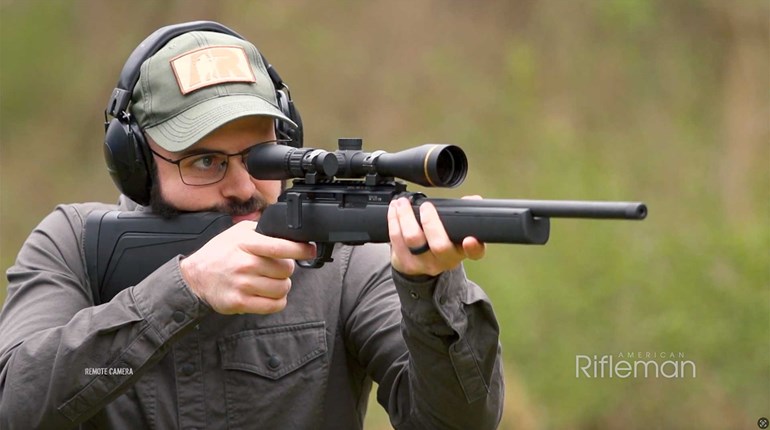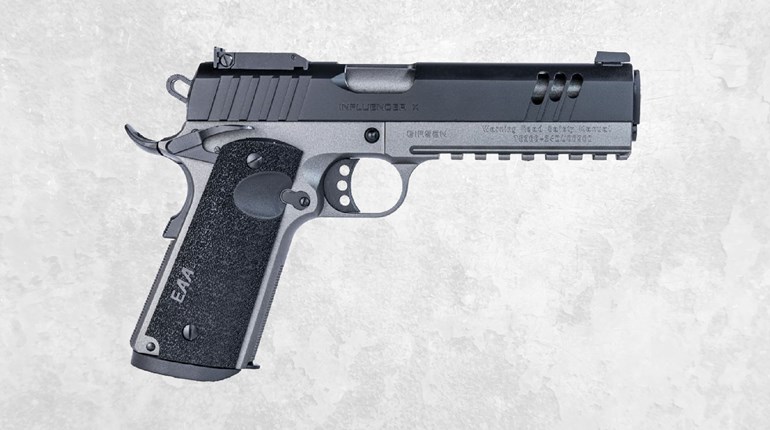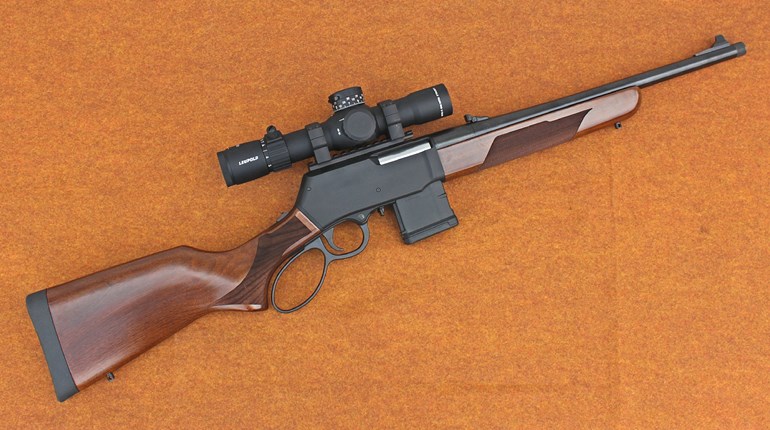
For many who enjoy the soft-shooting and affordable plinking that it provides, there's nothing all that special about .22 LR ammunition. So, it may come as a surprise to find out that .22 LR ammunition is a much more diverse and specialized round than you might expect. In fact, understanding the differences in various loads can help you to choose the best round for the job at hand.
.22 LR Bullets: Velocities, Types & Prices
The velocity, or speed, at which a .22 LR bullet is traveling when it leaves a barrel has a direct effect on its performance, meaning, how the bullet behaves in flight and on impact. Higher velocities increase the bullet's energy so that it will strike the target harder when it lands. But lower velocities can increase a bullet's stability which in turn contributes to improved accuracy.
Another performance component to consider is the bullet's weight. While heavier bullets can hit harder, lighter bullets can fly faster. Tinkering with bullet velocity and weight can make a cartridge less noisy to shoot.
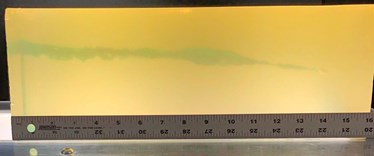
This ballistic gel block shows how the Federal Premium Punch load’s bullet velocity, weight and type work together for deep penetration in soft targets.
Next there is bullet type, which shapes the bullet's behavior when it lands. How do you want the bullet to interact with the target? Should it stay the same shape for improved penetration, expand to cause greater disruption or break apart to form multiple wound channels?
Last, but not least, there is ammunition quality. Just like any other commercial product, rimfire ammunition is available in different grades which in turn impacts how much a given load is going to cost. It's this tricky balancing act between velocity, energy, bullet type and ammunition quality that has led to the development of so many different loads for the ever popular .22 LR cartridge. Understanding these influential ammunition factors can help you choose which load is right for you.
The Four .22 LR Velocity Categories
To get a feel for how fast .22 bullets travel, it's helpful to have a reference point. A common unit of velocity that most folks recognize is the speed of sound, which is approximately 1,126 feet per second (fps) or 767 miles per hour. To break the sound barrier, or to go supersonic, a bullet needs to be traveling at 1,126 fps or faster.
The velocities of .22 LR bullets can range from around 500 fps at the very low end to somewhere over 1,800 fps at the high end, depending on the cartridge and gun used. In order to help folks keep track of the numbers, the industry has grouped velocities into four easier to remember categories:
1. Subsonic: 1,100 fps or Less
This ammunition class is specifically designed to avoid breaking the sound barrier. Going “supersonic” can destabilize the bullet a bit making it less accurate. Bullets do not pick up that added wobble when traveling at subsonic velocities, which lends to improved accuracy. Any bullet moving less than 1126 fps is technically traveling at subsonic speeds. But loads listed as Subsonic tend to keep bullets at velocities at around 1,100 fps or less. Subsonics are favored for improved accuracy activities like target shooting, reduced noise levels and for use with sound suppressors.
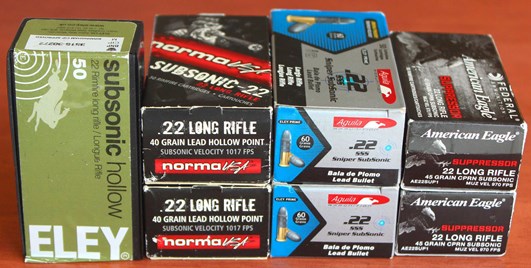
Bullets that don’t break the sound barrier tend to be more stable resulting in improved accuracy.
2. Standard Velocity: ~1,070-fps.
Standard Velocity rounds are a subset of subsonic loads with a much narrower range of velocities of around 1,050 fps to 1,080 fps with 1,070 fps being the “standard.” These are easy to identify because the words “Standard Velocity” are stamped on the box.
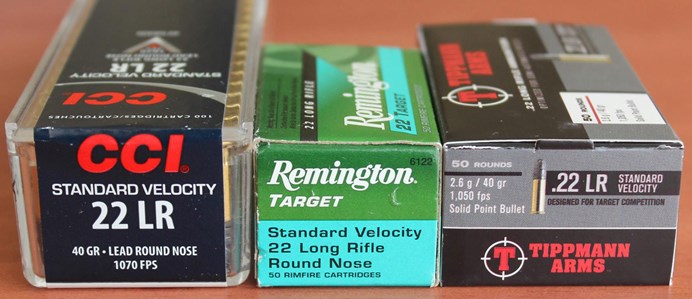
These subsonic loads are favored for target shooting and for use with sound suppressors.
3. High velocity 1,200-fps. to 1,310-fps.
When smokeless powder powered “high speed” or “high velocity” loads were introduced, they provided a marked increase in speed compared to their black powder predecessors. Today this velocity range represents a happy medium of velocity and bullet energy that is used for a wide variety of budget priced and premium loads.
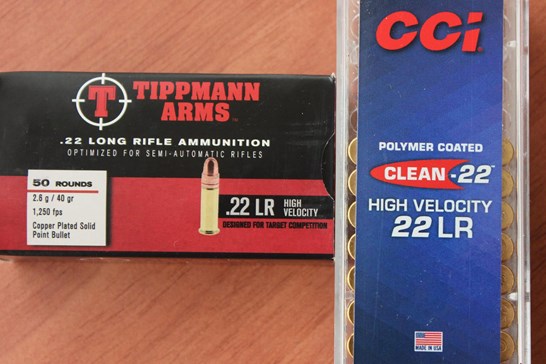
High-velocity loads are used to fill just about every .22 LR rifle role there is from plinking to small game hunting.
4. Hyper Velocity: 1,400-fps. to 1,800-fps.
These loads are all about satisfying the need for speed and maximizing the bullet's impact energy. Some rounds, like the CCI Stinger, use slightly longer cartridge cases and lighter bullets to achieve these velocities. These rounds are usually reserved for small game hunting and self defense.
Bullet Weights
Bullet weights used in .22 LR ammunition range from 20 gr. to 60 gr. The majority of premium and practice grade loads you'll find in sporting good stores are topped off with 40-gr. bullets along with a few 38-gr. and 36-gr. options to keep things interesting. The loads sporting bullets heavier than .40 grain, or lighter than 36 grain, tend to be more specialized. For example, Aguila Ammunition's Sniper Subsonic load uses a shortened cartridge case to accommodate an extra long 60-gr. bullet while then CCI Copper-22 round pushes a 21-gr. lead-free bullet at an impressive velocity of 1,850 fps.
Changes in bullet weight usually do not affect the reliable operation of semi-automatic rifles. However, most rimfire actions blowback operated. This means that light-weight bulleted loads, or subsonic loads, may not generate enough energy to cycle the action reliably resulting in jams and other malfunctions. Check your gun’s owner’s manual to see if it lists any ammunition recommendation such as, “Use high velocity loads with 40-gr. bullets for best results.”
Bullet Energy
The .22 LR is not considered to be a powerful cartridge when compared to just about any center-fire handgun or rifle cartridge. For this reason, rimfire hobbyists generally don't spend much time worrying about bullet energy since bullet velocity and weight are more relevant to finding a round that will run reliably in semi-automatics. For those who are interested, bullet energy is measured in foot-pounds (ft-lbs.) in the United States. Some manufacturers list bullet energy on the box or on their websites, others do not. If you have the velocity and the bullet weight, you can punch them into a free online bullet energy calculator to find the muzzle energy.
It should be noted here that listed ammunition performance numbers are generated by the manufacture in idea laboratory conditions using special test barrels that are often longer that typical rifle barrels. This means that bullets fired in real-world conditions are going to produce velocity and energy levels that are different than those listed on the box. Occasionally your numbers will be as good, or even better, than the manufacturer’s results. But most of time performance levels are less energetic than what’s listed on the box.
Bullet Types: Lead Bullets
The vast majority of .22 LR cartridges are topped off with relatively soft lead bullets that are treated with various coatings to reduce bore fouling. This list does not cover absolutely every possible permutation but it does touch on the more common types.
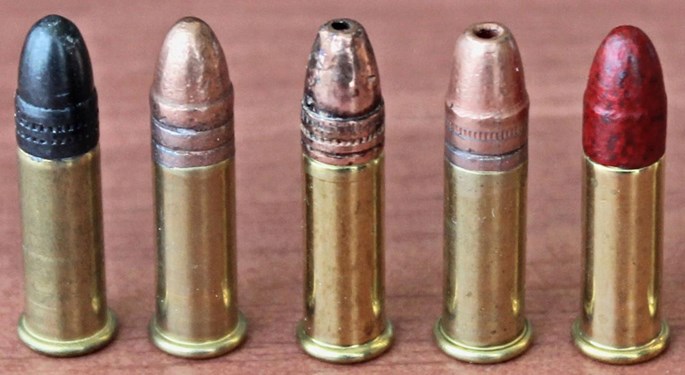
From left: Lead Round Nose (Waxed), Copper-Plated Round Nose, Two Different Copper-Plated Hollow Points, CCI Clean Polymer-Coated.
Lead Round Nose
This rounded, solid bullet is one of the oldest and most prolific types used in .22 LR ammunition. The lead is coated with wax which acts as a bullet lubricant and gives the bullets a distinctive black or gray appearance. These bullets are used for a full range of applications from budget priced plinking loads to premium-grade target loads. The primary down side with this bullet is that it’s relatively dirty and the waxy residue they produce can gum up the works of semi-automatic rifles faster than some other options.
Powder-Coated Round Nose
Remington uses a brass-colored powder coating on their Golden Bullet cartridges. I couldn't find a clear answer as to what this coating is made of but it takes the place of wax.
Copper-Plated Round Nose
As bullet velocity increases, so does the heat and friction as the bullet travels through the barrel. Coating the lead bullet with a thin layer of copper is a fairly inexpensive way to reduce barrel fouling. You don't usually have to guess if a .22 bullet is copper plated because the color gives it away.
Copper-Plated Hollow Points
Hollow points have a cavity, or hollow, in the tip. This opening allows the bullet to expand, or mushroom, when it strikes the target. The bullets must be going relatively fast in order to expand, so most hollow points are also copper plated. The majority of current production hollow points are shaped to feed reliably in semi-automatic rifles. But be aware that some older designs can cause jams in some guns.
Polymer-Coated Round Nose
In 2019, CCI launched its Clean series of .22 LR ammunition. Instead of wax or copper, the lead bullets are completely covered with a colorful polymer coating. This coating significantly reduces barrel and action fouling compared to waxed or copper-plated bullets.
Segmented Hollow Points
These hollow points are designed to breaking into three or four separate pieces upon impact. This results in multiple wound channels instead of just one. They are used for hunting and self defense.
Bullet Types: Specialty Loads
These cartridges are purpose-built with specific applications in mind.
“Quiet” and Colibri Loads
These rounds are designed to be as quiet as possible without the use of a sound suppressor. Reduced power powder charges launch the bullets slower than usual subsonic velocities (590 fps or 710 fps. for the two loads shown here) and in some cases light weight bullets are used. Reducing noise levels also reduces bullet energy but these rounds have enough oomph to be useful for pest control and target shooting. However, they usually do not generate enough energy to cycle semi-automatic actions reliably.
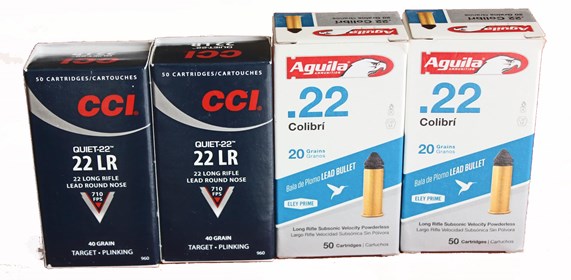
Extra quite loads sacrifice bullet energy for to reduce a rifles report.
Lead-Free Loads 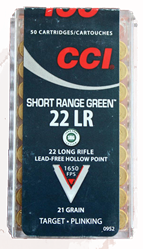
These cartridges are designed to meet the environmental regulations of states that require the use of lead-free ammunition. The bullets and the primer compounds are lead free. The bullet types available include solid copper, copper-plated tin and injection molded bullets comprised of copper dust and polymer (polymer-copper matrix). Lead-free loads usually cost more and launch lighter weight bullets than lead bulleted loads.
Pest Control Shells
These cartridges are literally miniature, rimfire shotgun shells. Filled with tiny pieces of lead birdshot, they are designed for short-range pest control including mice, rats and voles. These rounds can be safely fired in smooth bore guns or those with rifled barrels. But the barrel type and length changes the shot patterns significantly. Take a look at this review of the Henry Garden Gun to see these rounds in action.
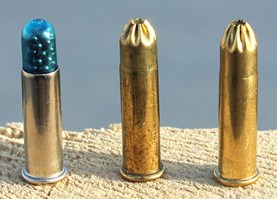
Rimfire shotshells are useful for dispatching garden-variety pests at close range.
Tracer Rounds
Much like the anti-aircraft cartridges used during World War II, .22 LR tracer rounds glow brightly as they fly through the air to their intended target. The Standard Velocity Piney Mountain cartridges shown here are topped with lead round nose bullets. The base of each bullet is treated with a pyrotechnic compound which is ignited by the burning of the propellant powder. Visible in daylight or low light conditions, the red or green light produced by the tracer provides a clearly visible flight path for 100 yards, or more, for training or just for fun. However, the burning compounds can set dry grass or brush on fire. Check your local regulations and outdoor conditions before using.
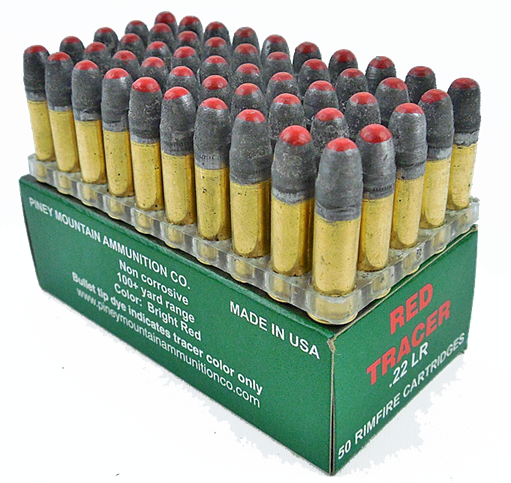
Tracers produce a visible flight path by burning brightly as they fly through the air.
Defensive Pistol Loads
In response to a renewed interest in rimfire pocket pistols and concealed carry revolvers, some manufacturers have recently launched a few .22 LR loads designed specifically for self defense with deep penetration or segmented bullet designs. These loads also perform well when fired from a rifles. Click here to see an evaluation of the award winning Federal Premium Punch load.
Cartridge Grades
When selecting centerfire pistol or rifle ammunition, the delineations between practice-grade, hunting-grade and self defense loads is relatively clear due to the types of bullets used and prices.
But with .22 LR ammunition the lines between cartridge classes are not as clearly drawn as the velocity categories. The various .22 LR bullet types are used across the classes. For example, wax coated lead round nose bullets are used at all price points. So, you have to lean on product information, packaging and pricing to choose which loads to go with.
But in the end, .22 LR rifles and handguns can be finicky about the ammunition they are fed. Each individual gun often has its own predilections and you'll have to test at least a few different loads to find the best balance of performance and reliability.
Practice Grade & General Purpose Loads
These budget-priced cartridges are intended for more casual pursuits like new-shooter training, informal target shooting and plinking away at soup cans and dirt clods. Common bullet types cover the full range from waxed lead round nose to copper-plated hollow points. Hollow point loads are more of a general- purpose round that can be used for target shooting or small game hunting. These rounds are packaged in small 50-round cardboard boxes, 300 to 550-round bulk boxes or polymer bottles and buckets.
The trade off with buying 'bulk box' loads is that the accuracy may not be quite as good as more expensive loads and there are likely to be a few rounds with faulty primers that go click! instead of bang! But the cost savings easily makes up the difference.
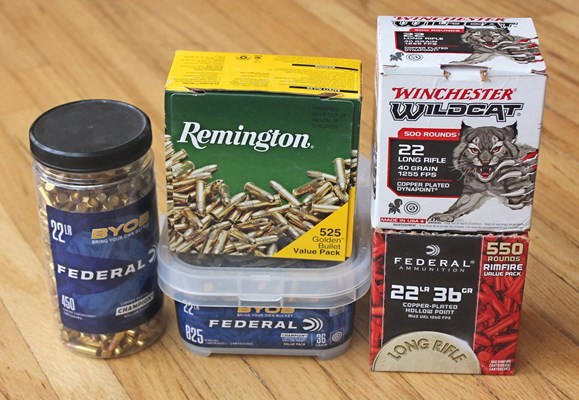
Buying in bulk can save money with practice-grade and general purpose loads.
Target & Match Grade
These loads are designed for amateurs and professionals who participate in organized target competitions. Accuracy is the primary goal with bullet velocities in the Subsonic to Standard range. Manufacturers are not shy about printing “Target”or '”Match” on the packaging. Although some target loads are not much more expensive than practice ammunition, others are priced like premium loads.
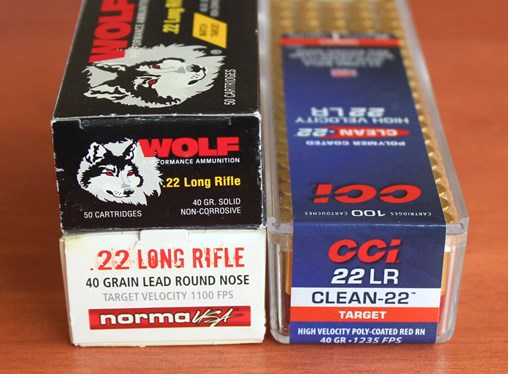
Target and Match loads are tuned for precision with bullets launching at lower velocities for improved stability.
Premium Loads
These are the creme-de-la-creme of the .22 LR options. They are usually, but not always, packaged in see through 50- or 100-round slide-top plastic boxes. This group includes high performance loads for hunting, specialty loads and defensive loads with relatively high price tags. They cost more but the pay offs include more reliable primers, high quality bullets and, in some cases, nickel plated cartridge cases.
If you would like to learn more about the venerable .22 LR cartridge, here are a few more rimfire related articles:
The .22 LR: History & Performance
What You Should Know About .22 Rimfire (How It’s Made)
.22 LR for Self Defense: Ammunition Test & Comparison












